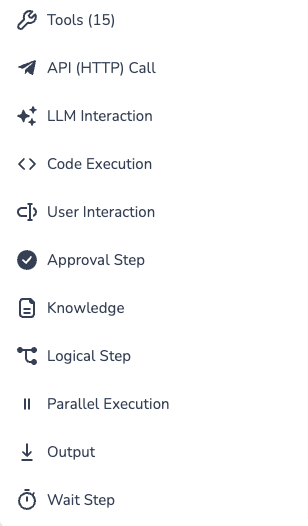Overview of the Tool Builder
The Tool Builder provides a flexible and intuitive interface for designing workflows by combining a variety of specialized steps. Each step serves a unique purpose, enabling you to create dynamic, modular, and efficient workflows. Below is a summary of the supported steps, along with links to detailed documentation for each:
Core Steps
-
Tools: Reuse existing tools to promote modularity and logic reuse.
-
API (HTTP) Call: Integrate external APIs by sending HTTP requests to fetch or modify data.
-
LLM Interaction: Utilize large language models (LLMs) for natural language processing and AI-driven tasks.
-
Code Execution: Execute custom Python code snippets for advanced logic or computations.
-
User Interaction: Collect input or actions from users to guide the workflow.
-
Approval Step: Introduce checkpoints for human validation or administrative approval.
-
Knowledge: Query the knowledge base for relevant information.
-
Wait Step: Pause the workflow for a specified duration or until a specific time.
-
Branches (Logical Step and Parallel Execution): Enable conditional logic and parallel processing to create dynamic workflows.
-
Output: Define the final result to be returned to the agent or end-user.

Common Functionality Across Steps
All steps in the Tool Builder share common features that enhance flexibility and adaptability:
-
Step Outputs: Most steps allow you to define an output variable to store the result, which can be used in subsequent steps (except Logical Step and Parallel Execution).
-
Dynamic Parameter Injection: Inject parameters, variables, or context values into step configurations using the / command palette or by selecting from a list. These values dynamically update at runtime to reflect the current state of the workflow.
-
Seamless Data Flow: Outputs from one step can be passed as inputs to subsequent steps, ensuring smooth data transitions throughout the workflow.
For more details on common functionality, refer to the Parameters, variables, context and data flow.
Step-Specific Documentation
Below is a quick reference to the detailed documentation for each step:
-
Nesting Tools and reusing logic
Reuse existing tools to simplify workflows and promote modularity. -
API (HTTP) Call
Send HTTP requests to interact with external APIs, supporting methods like GET, POST, PUT, PATCH, and DELETE. -
LLM Interacton
Leverage AI capabilities for natural language understanding and processing. -
Code Execution
Run Python code snippets for custom logic and computations. -
User Interaction
Collect user input, validate responses, and guide the workflow based on user actions. -
Approval Step
Add human validation for critical operations to ensure compliance and reduce risks. -
Knowledge Node
Query and retrieve information from the knowledge base. -
Wait Step
Introduce delays or pauses in the workflow for synchronization or timing purposes. -
Steps, branches and ouputs
Implement conditional logic and parallel processing for dynamic branching. -
Output
Define the final result of the workflow, including text, JSON, or media files.
E-learning Video
For further guidance, watch our e-learning videos:
